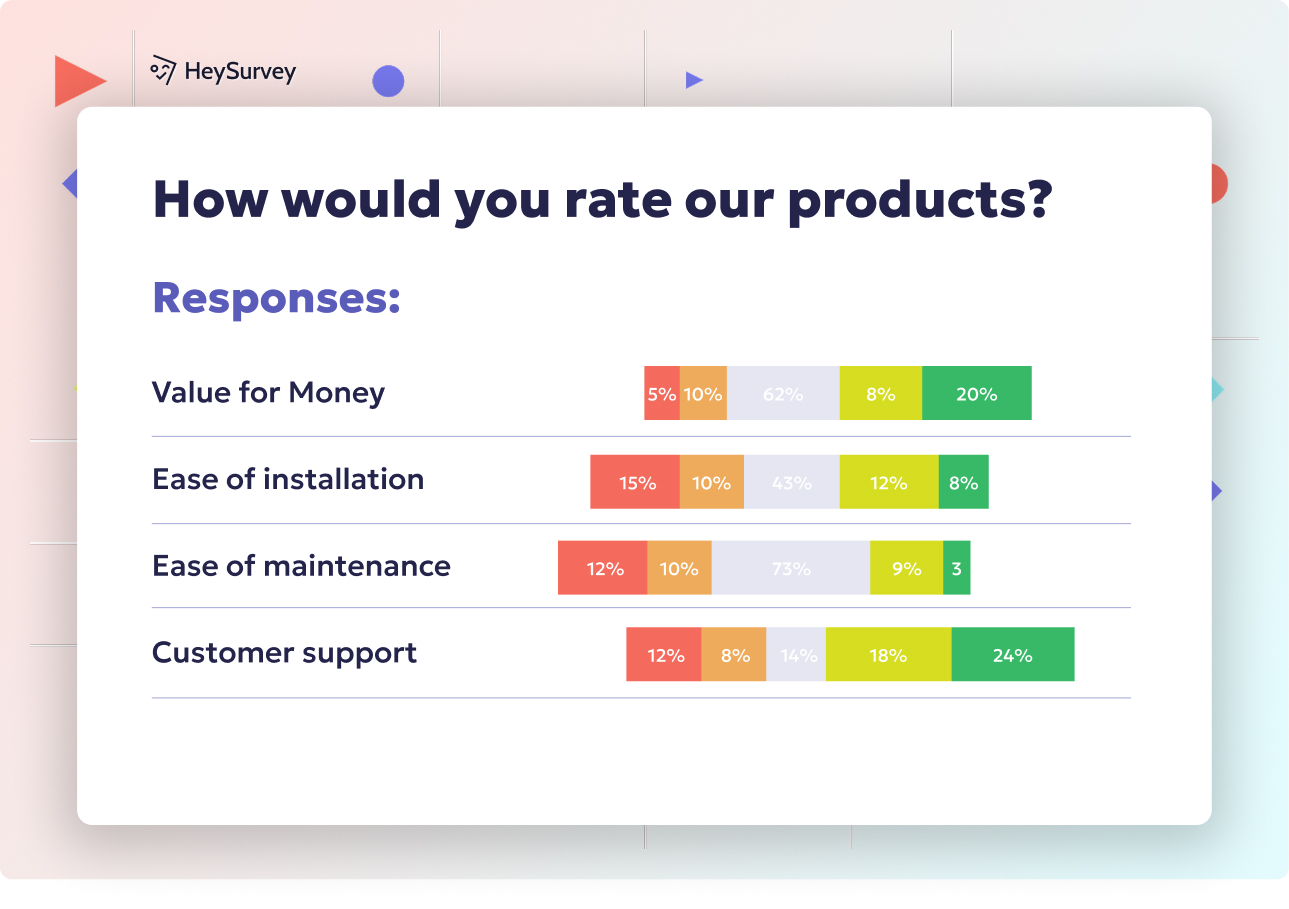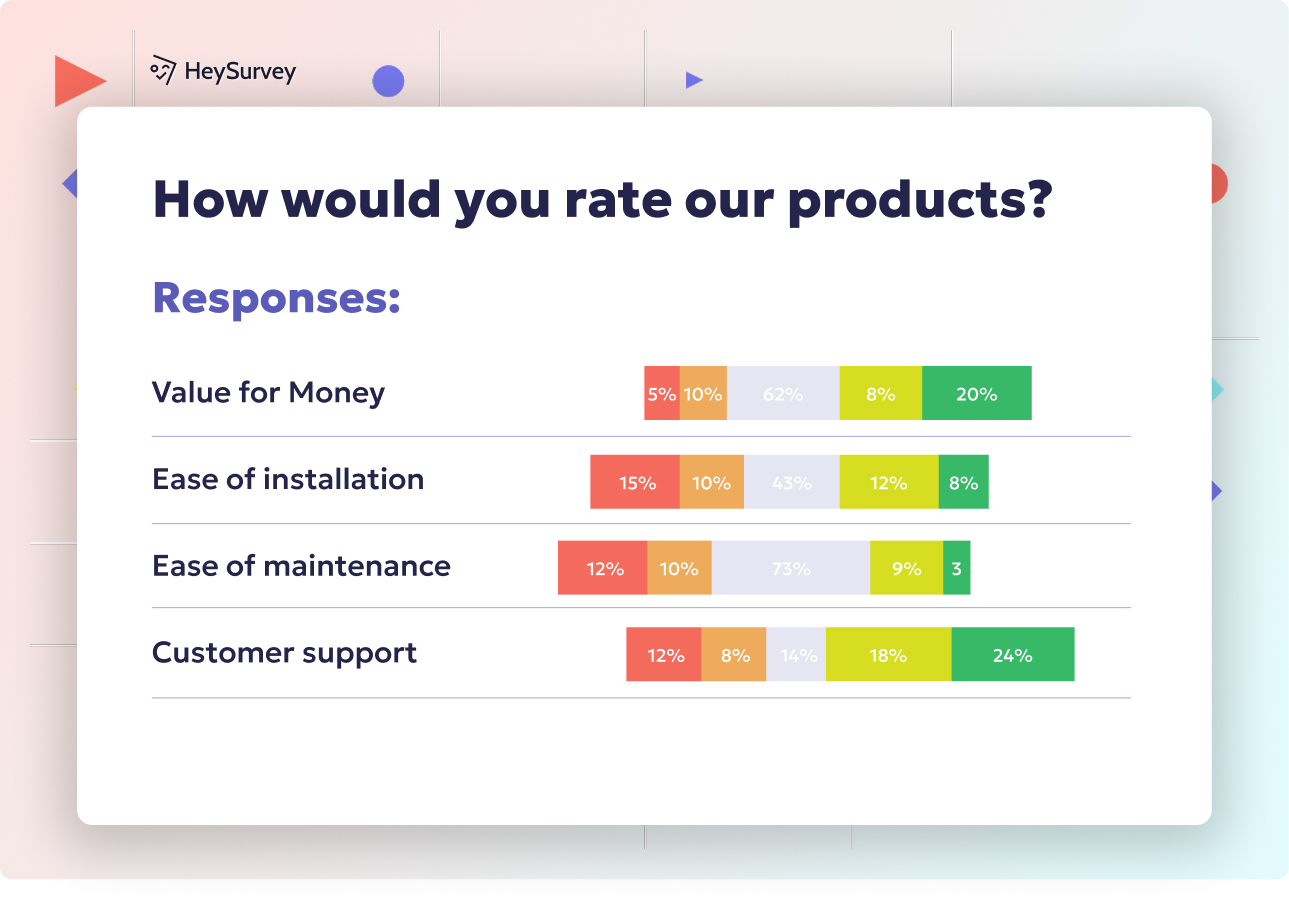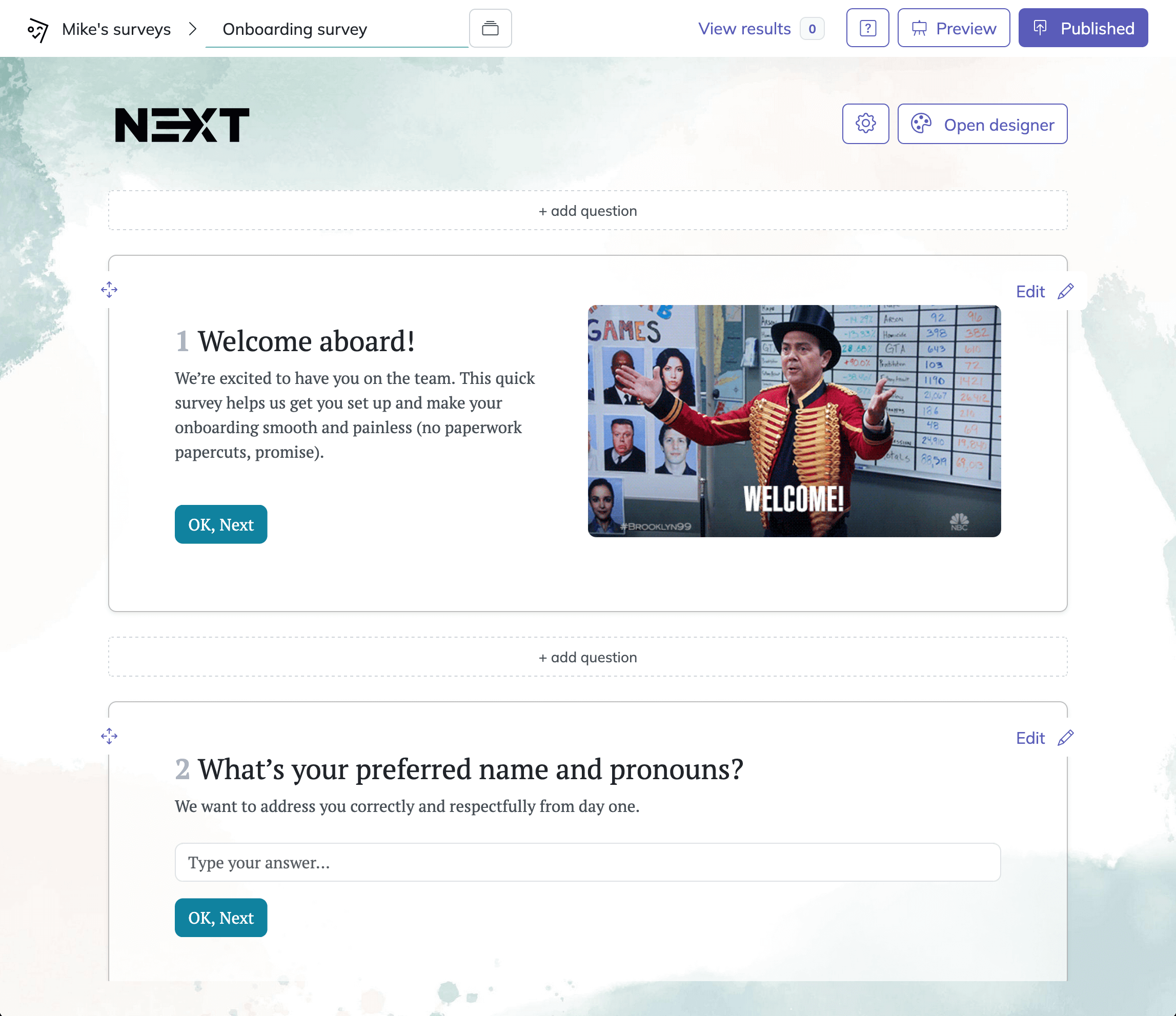32 Faculty Satisfaction Survey Questions for Higher Ed Success
Discover 25 practical faculty satisfaction survey questions covering job satisfaction, resources, leadership, work-life balance, and more insights.
Colleges and universities are always on the hunt for insights to retain great faculty, sharpen their reputation, and create standout learning environments. One of the most powerful tools for this mission is a faculty satisfaction survey—a structured opportunity to capture honest feedback, track faculty engagement, and refine higher-ed employee feedback processes. Institutions may roll out faculty satisfaction surveys at the end of each term, annually, or in response to campus policy shake-ups. No matter the timing, getting the questions right makes the difference between surface polite nods and real, actionable insight.
Overall Job Satisfaction Survey
Why & When to Use
Capturing a big-picture sense of faculty satisfaction can feel like gazing out over the academic horizon with a fresh cup of coffee—invigorating and essential. The overall faculty job satisfaction survey steps in before major strategy decisions or funding announcements to check how everyone’s really doing. It’s a smart move ahead of resource-allocation cycles or as the “before” picture for comparing future deep-dives into specific issues.
Leaning on broad survey data is a baseline best friend, offering a snapshot of faculty morale that can be tracked year over year.
You’ll find it’s handy for: * Benchmarking institutional culture shifts. * Informing retention and recruitment strategies. * Validating whether recent organizational changes have landed well—or fizzled.
Sample Questions
How satisfied are you with your current role at the institution?
To what extent does your workload feel manageable?
How likely are you to recommend this institution as an employer to other academics?
Do you feel your compensation is fair compared with similar institutions?
Overall, how satisfied are you with your day-to-day responsibilities?
Best Practices and Tips
Focus on holistic satisfaction in these surveys. * Review trends broadly before zooming in on specifics. * Use survey data as internal HR compass points. * Keep language welcoming—and accessible to new and seasoned staff alike.
By balancing concise questions with a touch of warmth, you show that well-being is more than a box-checking exercise.
Faculty satisfaction surveys are crucial for assessing institutional culture, informing retention strategies, and validating organizational changes. (driveresearch.com)

Creating a faculty satisfaction survey with HeySurvey is a breeze—even if you’re new to the platform! Just follow these three simple steps, and you’re on your way to gathering valuable higher-ed employee feedback.
Step 1: Create a New Survey
Head over to HeySurvey and start by choosing how you want to create your survey. You can:
Select a pre-built template tailored for faculty surveys to save time.
Or opt for an empty sheet if you want full control from scratch.
Once you pick your starting point, give your survey a clear internal name so you can identify it easily later on.
A handy tip: You can start without creating an account just to explore the editor. When ready to publish, signing up is quick and free!
Step 2: Add Your Questions
Now comes the fun part—crafting your questions! Use the Add Question button to start adding your carefully chosen faculty satisfaction survey questions. HeySurvey supports all the question types you need, from:
Likert scales for measuring agreement and satisfaction.
Multiple-choice or single-choice options.
Open-ended text responses for richer insights.
Don’t forget you can mark important questions as required to ensure useful responses. If you want to get fancy, use branching logic to tailor questions based on previous answers—perfect for diving deeper into specific issues.
To speed things up, duplicate similar questions or add images to jazz up your survey’s look. The text editor also supports basic formatting, so your questions can be clear and engaging.
Step 3: Publish Your Survey
Happy with your questions? Great! Hit the Publish button to make your faculty satisfaction survey live. HeySurvey generates a shareable link you can email or embed on your institution’s website.
Remember, publishing requires a free account to store and access responses securely.
Your survey will be fully responsive, looking great on desktops, tablets, and phones alike—making it easy for faculty to respond anytime, anywhere.
Bonus Step 1: Apply Branding
Want your survey to feel truly institutional? Upload your logo via the branding options to customize the top left corner of the survey. Adjust colors, fonts, and layouts in the Designer Sidebar to match your school’s style. This small touch boosts professionalism and faculty trust.
Bonus Step 2: Define Survey Settings
Jump into the Settings Panel to fine-tune availability by:
Setting start and end dates for when the survey is active.
Limiting the number of responses you’ll accept.
Adding a custom redirect URL respondents see after submission.
You can even allow respondents to view summary results for certain question types—a neat way to share progress transparently.
Bonus Step 3: Skip Into Branches
Branching transforms a simple survey into a personalized conversation. Configure questions so the next item depends on a faculty member’s previous answer, making each response more relevant and engaging.
For example, if someone rates workload as unmanageable, you can automatically skip to detailed questions about resources or stress support.
Ready to start? Launch the faculty satisfaction survey template below and watch HeySurvey do the heavy lifting!
Teaching Resources & Classroom Support Survey
Why & When to Use
No professor wants to feel like they’re teaching Shakespeare over a megaphone in a broom closet (unless it’s experimental theatre). That’s where the faculty teaching resources survey questions shine—helping highlight what’s working and what needs fixing when it comes to classroom support. These surveys are invaluable at the start or end of a semester, letting departments nip tech or materials issues in the bud.
Frequent administration helps: * Uncover pain points with instructional technology. * Identify shortages in TA/grader assistance. * Clarify if learning materials arrive on time, every time.
Sample Questions
How adequate are the physical classroom facilities for your teaching needs?
Rate the availability of teaching assistants or graders in your department.
How satisfied are you with access to instructional technology (e.g., smart boards, LMS tools)?
Are learning materials (textbooks, software) provided in a timely manner?
How effective is the instructional design support available to you?
Best Practices and Tips
Highlight faculty feedback on classroom resources. * Consider customizing questions for teaching modalities (online, hybrid, in-person). * Use faculty suggestions to guide investments in tech or tools. * Loop back with results—faculty love seeing tangible upgrades in response to their feedback.
Earning a gold star for resources isn’t just about avoiding complaints—it’s about fueling passionate, inspiring teaching from the front lines.
Shared governance may be more important than money in determining faculty satisfaction. (aaup.org)
Professional Development & Career Advancement Survey
Why & When to Use
Ambitious faculty members want more than a desk and a syllabus; they want to grow. A faculty professional development survey shines a gentle, revealing spotlight on opportunities for learning and advancement. Running these yearly, or after launching shiny new programs, uncovers what’s hot (or not) in professional support.
Such surveys help: * Track satisfaction with research funding. * Reveal gaps in mentorship for junior or mid-career faculty. * Pinpoint barriers to advancement in the promotion and tenure maze.
Sample Questions
How satisfied are you with available research funding opportunities?
Rate the effectiveness of mentorship programs for junior faculty.
How clear are the promotion and tenure criteria?
To what extent does the institution support conference attendance?
How valuable are the professional development workshops you’ve attended?
Best Practices and Tips
Highlight support for faculty advancement. * Make sure you ask about both formal and informal development resources. * Use candid responses to tweak training or symposium offerings. * Celebrate wins and adjust where enthusiasm is, well, tepid.
A playful approach can spark honest dialogue, boosting buy-in and professional pride campus-wide.
Institutional Policies & Governance Survey
Why & When to Use
Ever feel like policy updates get dropped from the top of a tower, sans explanation? Enter the faculty governance satisfaction survey. This survey picks up on how confidently faculty can navigate the labyrinth of institutional rules, and how much influence they carry in the process.
The best timing is after any round of policy changes, accreditation reviews, or when rumors of “mysterious new rules” swirl in the break room.
It’s perfect for: * Testing how well changes are communicated to every corner of campus. * Gauging faculty involvement in decision-making. * Checking confidence in promotion and tenure processes.
Sample Questions
How satisfied are you with the clarity of institutional policies affecting faculty?
Do you feel faculty voices are represented in governance decisions?
How effective is communication regarding policy changes?
Rate the fairness of the promotion and tenure process.
How transparent are budget allocation decisions that impact your work?
Best Practices and Tips
Stress shared governance clarity. * Ask about clarity, fairness, and transparency in separate questions. * Look for trends in faculty trust regarding leadership. * Share results with the community—transparency boosts trust.
When faculty know what’s coming (and how they can weigh in), a little policy debate turns into productive progress.
Faculty satisfaction is more strongly associated with shared governance and institutional leadership than with compensation and support for teaching, research, and service. (aaup.org)
Campus Culture & Work-Life Balance Survey
Why & When to Use
A sweet work-life blend is less wishful thinking and more a campus must-have these days. With faculty work-life balance survey questions, institutions can sprinkle some much-needed empathy into the annual data diet. These surveys land well mid-term or after major inclusivity efforts to track how the climate truly feels for faculty.
This approach uncovers: * The true inclusivity of the campus. * Hidden challenges with flexible schedules or family-friendly perks. * Support for mental health and overall well-being.
Sample Questions
How inclusive do you find the campus culture for diverse faculty?
Rate your ability to maintain a healthy work-life balance here.
How supported do you feel regarding family-friendly policies (e.g., childcare, parental leave)?
Do you experience a sense of community with colleagues across departments?
How effectively does the institution address issues of harassment or discrimination?
Best Practices and Tips
Feature campus community and wellness. * Invite honest answers with safe, neutral language. * Use feedback to update family policies, event planning, or wellbeing resources. * Prominently share progress—inclusivity loves the limelight.
Bold questions about support and belonging can make faculty feel their voices aren’t just heard, but truly valued.
Leadership & Communication Survey
Why & When to Use
Change in academic leadership can feel like a gusty wind through the faculty lounge. The faculty leadership satisfaction survey cuts through the noise, measuring how leadership vision and communication land on the ground. Run it right after new chancellors take the helm, or following a shiny new strategic plan.
What this reveals: * How faculty interpret the direction set by senior leadership. * Gaps in communication between departments and the administration. * Whether leaders are accessible and open to feedback.
Sample Questions
How confident are you in the strategic vision communicated by senior leadership?
Rate the transparency of departmental leadership decisions.
How timely is communication regarding institutional changes?
Do leaders seek faculty input before implementing major initiatives?
How accessible are senior administrators for feedback or concerns?
Best Practices and Tips
Emphasize leadership transparency and involvement. * Keep the tone approachable—faculty are more candid when questions feel inviting. * Seek out stories or examples with open-ends for deeper insight. * Share back how feedback drives real leadership change.
Open questions on leadership style can transform “out of touch” into “in tune”—if feedback leads to visible action.
Technology & Remote Teaching Support Survey
Why & When to Use
There’s nothing like a Lockdown Browser pop-up or a half-working Zoom link to turn a great class into chaos. That’s why remote teaching faculty survey questions shine brightest after a rush of new LMS features or changes in teaching formats. Digital readiness is everything.
This survey will: * Pinpoint persistent tech glitches that stall coursework. * Track faculty confidence in shifting between classroom and keyboard. * Rate IT support and the effectiveness of training resources.
Sample Questions
How reliable is the institution’s learning management system?
How adequate is IT support for troubleshooting classroom technology?
How prepared do you feel to deliver courses online or in hybrid formats?
Are virtual office-hour tools effective for student engagement?
How satisfied are you with training resources on emerging educational technologies?
Best Practices and Tips
Shine a light on faculty digital experience. * Regularly update questions as new tech tools roll out. * Ask about both hardware and software frustrations. * Treat tech training as ongoing, not “set it and forget it.”
With regular pulse checks, the digital classroom hums more than it hiccups—fueling confident, creative teaching.
Exit Survey for Departing Faculty
Why & When to Use
Parting may be sweet sorrow, but the faculty exit survey questions deliver priceless insight into why faculty say goodbye. These are must-haves in the offboarding checklist to help institutions spot chronic pain points and freshen up retention plans.
These exit interviews will: * Surface recurring issues leading to turnover. * Pinpoint which changes might have convinced a faculty member to stay. * Gauge whether the institution lived up to its promises.
Sample Questions
What primary factors influenced your decision to leave the institution?
How would you rate your overall experience working here?
Which institutional changes could have encouraged you to stay?
How effectively were your professional growth needs met?
Would you consider returning to this institution in the future?
Best Practices and Tips
Keep the tone focused on honest feedback for improvement. * Make surveys confidential to inspire true candor. * Ask what would turn a “no” into a “maybe” on return. * Use results to reshape onboarding, mentorship, and policies for those who remain.
Every goodbye is a chance to say hello to a better workplace for those who stay—if you truly listen.
Best Practices for Crafting Faculty Satisfaction Survey Questions (Dos and Don’ts)
Before drafting your next blockbuster survey, it’s time for a quick best-practices huddle. Developing best practices for faculty surveys isn’t rocket science, but it does require a bit of finesse (and maybe a well-placed cat meme).
- Define clear objectives for each type of survey.
- Use both Likert scales for benchmarking and open-ended questions for storytelling.
- Cap surveys at 10–15 minutes—faculty are busy!
- Guarantee anonymity to boost participation and candor.
- Avoid leading or double-barreled questions; keep language neutral and clear.
- Pilot-test with a handful of willing faculty to catch unclear phrasing or survey fatigue.
Your aim? Surveys that are: * Simple * Welcoming * Friction-free * Designed to unearth actionable insights
Less is usually more here. The right questions, in the right mix, invite response rates that make institutional data geeks giddy—with feedback your dean will actually want to read.
Taking the time to get your faculty satisfaction survey questions right pays off in real improvements to morale, workflow, and the entire campus vibe. Whether you’re focused on teaching resources, leadership, or work-life harmony, question design is where real transformation begins.
Every great campus evolves, and the best ones do so guided by honest, well-crafted feedback. Faculty satisfaction surveys aren’t just forms to fill—they’re how you catch the pulse of your academic heart. When crafted with care and a touch of playfulness, these surveys lead to meaningful change, happier faculty, and stronger institutions, year after year.
Related Employee Survey Surveys

29 Essential Post Mortem Survey Questions for Project Success
Discover 25+ essential post mortem survey questions to improve projects, boost team morale, and d...

31 Change Readiness Survey Questions to Boost Your Success
Discover 25+ sample change readiness survey questions to assess attitudes, barriers, and confiden...

31 Retreat Survey Questions to Collect Actionable Feedback
Discover 26 essential retreat survey questions to gather actionable feedback before, during, and ...
